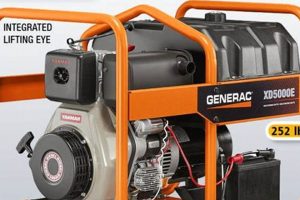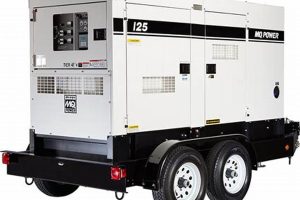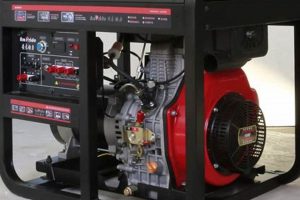Compact, fuel-powered electricity sources capable of independent operation are essential for a variety of applications across India. These units, typically fueled by diesel, offer a reliable power supply for locations lacking grid access or experiencing frequent outages. Examples include construction sites, remote villages, mobile businesses, and emergency services. They offer a practical solution for powering essential equipment and appliances.
The significance of these independent power sources stems from India’s evolving energy landscape. Factors such as increasing power demands, infrastructure limitations, and the pursuit of energy independence contribute to their growing adoption. Historically, reliance on grid electricity has presented challenges for continuous operation, especially in areas with unreliable infrastructure or during natural disasters. These self-contained units offer a crucial bridge, ensuring uninterrupted power for vital services and economic activities.
This article will further explore key aspects of these devices, including various sizes and power outputs available, selection criteria, maintenance requirements, and the latest advancements in fuel efficiency and emission control technologies.
Operational and Maintenance Tips for Diesel Generators
Proper operation and maintenance are crucial for maximizing the lifespan and ensuring the reliable performance of independent diesel-powered generators. The following tips offer guidance for effective management of these units.
Tip 1: Regular Load Testing: Periodically operating the unit under a typical load helps identify potential issues early and ensures components remain in working order. This also helps prevent wet stacking, a condition caused by prolonged low-load operation.
Tip 2: Fuel Management: Utilize clean, high-quality diesel fuel and maintain a full tank whenever possible. This minimizes condensation and prevents microbial growth within the fuel system. Regularly drain any accumulated water from the fuel tank.
Tip 3: Oil Changes and Filter Replacement: Adhere to the manufacturer’s recommended intervals for oil changes and filter replacements (both fuel and air filters). Clean oil and filters are essential for optimal engine performance and longevity.
Tip 4: Cooling System Maintenance: Regularly inspect coolant levels and ensure the radiator fins are free from debris. Proper cooling is vital for preventing engine overheating and damage.
Tip 5: Battery Care: Keep battery terminals clean and check electrolyte levels regularly. A well-maintained battery ensures reliable starting, especially during emergencies.
Tip 6: Exhaust System Inspection: Regularly inspect the exhaust system for leaks or blockages. A properly functioning exhaust system is crucial for safe operation.
Tip 7: Ventilation: Ensure adequate ventilation around the generator during operation. This prevents overheating and directs exhaust fumes safely away from the unit and any enclosed spaces.
Following these maintenance practices will contribute significantly to the longevity and dependable performance of the power generation equipment, ensuring a consistent power supply when needed.
By understanding and implementing these operational and maintenance procedures, users can maximize the return on their investment and ensure a reliable power source for years to come. This proactive approach to maintenance is vital for uninterrupted operation and minimizes the risk of unexpected power failures.
1. Power Output
Power output, measured in kilowatts (kW), represents a critical specification for portable diesel generators in India. This metric directly dictates the generator’s capacity to power electrical equipment and appliances. Selecting an appropriately sized generator requires careful consideration of the intended load. Underestimating power requirements can lead to overloading and potential generator damage, while overestimating leads to unnecessary fuel consumption and higher operating costs. For instance, a construction site operating heavy machinery demands a significantly higher power output compared to a small shop powering basic lighting and appliances.
Matching power output to specific needs is crucial for efficient and reliable operation. A common practice involves calculating the total wattage required for all intended devices and adding a safety margin. This margin typically ranges from 20% to 30% of the total load, ensuring the generator operates within its optimal range and accommodates potential future power demands. Consider a scenario where a medical clinic requires a generator for essential equipment like ventilators and refrigerators. Accurately determining the combined power draw of these devices, including surge currents during startup, is critical for selecting a generator with sufficient capacity to maintain uninterrupted operation during power outages.
Careful power output selection is fundamental for successful generator implementation across diverse applications in India. Understanding power requirements ensures efficient resource utilization, prevents equipment damage, and maintains reliable power supply for crucial operations. This aspect directly impacts operational costs and the overall effectiveness of portable diesel generators in meeting specific power needs. It further emphasizes the importance of professional consultation when sizing a generator to ensure optimal performance and longevity.
2. Fuel Efficiency
Fuel efficiency represents a critical operational parameter for portable diesel generators in India, directly impacting running costs and environmental impact. Expressed as liters per hour or gallons per hour at a given load, this metric reflects how effectively the generator converts diesel fuel into usable electrical energy. Higher fuel efficiency translates to lower operating costs, particularly crucial in extended operation scenarios or regions with fluctuating fuel prices. This factor is further amplified in India, where fuel costs constitute a significant portion of generator operating expenses.
Several factors influence fuel efficiency, including engine design, load percentage, and maintenance practices. Modern generators often incorporate advanced technologies such as electronic fuel injection and optimized combustion chambers to maximize fuel utilization. Operating the generator at its optimal load range, typically between 50% and 80% of its rated capacity, significantly impacts fuel consumption. Regular maintenance, including air filter replacement and fuel system cleaning, ensures optimal engine performance and contributes to improved fuel economy. For example, a construction company operating a generator continuously for several hours daily can achieve substantial cost savings by prioritizing fuel-efficient models and implementing proper maintenance protocols.
The practical significance of fuel efficiency extends beyond economic considerations. Reduced fuel consumption directly translates to lower emissions, contributing to a smaller environmental footprint. In a nation striving for sustainable development, the emphasis on fuel-efficient generators aligns with broader environmental goals. Ultimately, understanding and prioritizing fuel efficiency in portable diesel generator selection and operation is crucial for both economic viability and environmental responsibility within the Indian context. This focus promotes sustainable practices within various sectors utilizing these power sources.
3. Portability
Portability is a defining characteristic of these generators, directly influencing their suitability for various applications across India. This attribute encompasses factors such as physical size, weight, and the presence of features like wheels or lifting handles. The degree of portability dictates the ease with which a generator can be transported and deployed in different locations. This is particularly relevant in India, where diverse terrains and accessibility challenges often necessitate easily maneuverable power sources. For instance, disaster relief efforts benefit significantly from highly portable generators that can be quickly deployed to affected areas. Similarly, construction projects in remote locations, often with limited access to heavy transport, rely on compact, easily transportable generators.
The practical implications of portability extend beyond mere convenience. In scenarios requiring temporary power solutions, such as outdoor events or mobile medical camps, portability is paramount. The ability to quickly relocate and set up a generator allows for flexible power distribution in dynamic environments. Furthermore, portability influences storage requirements and overall logistical management. Smaller, lighter units simplify storage and transportation, reducing associated costs and logistical complexities. For businesses operating in urban areas with limited storage space, compact portable generators offer a practical solution for backup power needs.
In essence, portability is a critical factor shaping the utility and versatility of portable diesel generators in India. This characteristic enables diverse applications across various sectors, from emergency services and construction to small businesses and rural electrification initiatives. The ability to efficiently transport and deploy these power sources enhances operational flexibility and expands access to reliable electricity in diverse contexts across India. Understanding the nuances of portability empowers informed decision-making, ensuring the selected generator aligns with specific mobility and deployment requirements.
4. Maintenance
Regular maintenance is essential for the reliable and long-term operation of portable diesel generators in India. Neglecting routine upkeep can lead to decreased performance, increased fuel consumption, costly repairs, and a shortened lifespan. Given the critical role these generators often play in providing power for essential services, a proactive maintenance approach is crucial. The following facets highlight key maintenance requirements:
- Regular Oil Changes
Engine oil degrades over time, losing its lubricating properties and accumulating contaminants. Regular oil changes, as per the manufacturer’s recommendations, are essential for maintaining optimal engine performance and preventing premature wear. Using the correct oil viscosity grade, specific to the generator’s engine and operating environment, is crucial. In the hot and dusty conditions often prevalent in India, adhering to recommended oil change intervals becomes even more critical.
- Air Filter Maintenance
Clean air filters are essential for efficient combustion and preventing engine damage. Dust and debris can clog air filters, restricting airflow and reducing engine performance. Regular cleaning or replacement of air filters, particularly in dusty environments common in India, is crucial for maintaining optimal generator operation. Neglecting air filter maintenance can lead to increased fuel consumption and potential engine damage.
- Fuel System Upkeep
Maintaining a clean fuel system is vital for preventing issues such as clogged injectors and fuel pump failure. Regularly draining water and sediment from the fuel tank helps prevent corrosion and microbial growth. Using high-quality diesel fuel and adding fuel stabilizers, especially during periods of infrequent use, can further enhance fuel system reliability. In the Indian context, where fuel quality can sometimes vary, these practices become particularly important.
- Cooling System Checks
The cooling system plays a critical role in preventing engine overheating. Regularly inspecting coolant levels, ensuring adequate coolant concentration, and checking for leaks are essential maintenance tasks. Periodically cleaning the radiator fins of dust and debris helps maintain optimal cooling efficiency, particularly important in India’s warmer climates.
These maintenance procedures are interconnected and contribute to the overall reliability and longevity of portable diesel generators in India. Adhering to a comprehensive maintenance schedule, tailored to the specific operating conditions and manufacturer’s recommendations, ensures consistent performance, minimizes downtime, and reduces long-term operating costs. This proactive approach to maintenance safeguards the investment and ensures a dependable power source for critical applications across various sectors in India.
5. Emissions
Portable diesel generators, while providing essential power in India, inherently produce emissions. These emissions primarily consist of nitrogen oxides (NOx), particulate matter (PM), carbon monoxide (CO), and unburnt hydrocarbons (HC). The environmental impact of these pollutants necessitates careful consideration and mitigation strategies. NOx contributes to smog formation and respiratory problems, while PM poses significant health risks, particularly in densely populated areas. CO is a toxic gas, and HC contributes to ground-level ozone formation. The quantity and composition of emissions depend on factors such as engine technology, fuel quality, and maintenance practices. Older generators typically produce higher emission levels compared to modern units equipped with advanced emission control technologies. For instance, a construction site operating multiple generators in close proximity to residential areas must consider the cumulative impact of emissions on local air quality.
Addressing emission concerns requires a multi-pronged approach. Utilizing high-quality diesel fuel with low sulfur content can significantly reduce particulate matter emissions. Regular maintenance, including proper engine tuning and efficient combustion, minimizes the release of unburnt hydrocarbons and carbon monoxide. Modern generators often incorporate technologies like diesel particulate filters (DPFs) and selective catalytic reduction (SCR) systems to further reduce emissions. These technologies, while effective, require regular maintenance and periodic replacement of consumable components, adding to the overall operating costs. In environmentally sensitive areas or regions with stringent emission regulations, implementing these advanced control technologies becomes increasingly crucial. For example, hospitals or data centers relying on backup power generation must prioritize low-emission solutions to minimize their environmental impact and ensure compliance with local regulations.
Mitigating emissions from portable diesel generators is essential for balancing the need for reliable power with environmental protection in India. Adopting cleaner fuels, implementing proper maintenance protocols, and integrating advanced emission control technologies are crucial steps toward minimizing the environmental footprint of these power sources. Understanding the composition and impact of emissions allows for informed decision-making, promoting sustainable practices and safeguarding public health. Furthermore, ongoing research and development efforts focus on developing cleaner combustion technologies and alternative fuels, paving the way for even more environmentally friendly power generation solutions in the future.
6. Cost
Cost considerations play a significant role in the acquisition and operation of portable diesel generators in India. The initial purchase price varies depending on factors such as power output, features, and brand reputation. Higher power output generators generally command a higher price tag, while units equipped with advanced features like automatic start/stop functionality or remote monitoring systems also contribute to increased upfront costs. Brand reputation and warranty terms further influence pricing. For instance, a small business owner might prioritize a cost-effective generator with basic features, while a large industrial facility might opt for a higher-priced, more robust generator with advanced capabilities and a longer warranty period. Understanding the trade-offs between initial investment and desired features is crucial for making informed purchasing decisions. This initial purchase price, however, represents only one component of the overall cost equation.
Operational costs constitute a significant and ongoing expense associated with portable diesel generators. Fuel consumption is a primary driver of these costs, directly influenced by the generator’s fuel efficiency and operating hours. Regular maintenance, including oil changes, filter replacements, and periodic servicing, adds to the operational expenditure. The cost of spare parts and potential repairs further contributes to the overall cost burden. Consider a scenario where a hospital relies on a diesel generator for backup power. The cost of ensuring continuous operation during extended power outages can be substantial, factoring in fuel consumption, maintenance, and potential repairs. Therefore, evaluating both the initial purchase price and long-term operational costs is essential for accurate cost projections and informed decision-making.
Effectively managing the cost of portable diesel generators requires a comprehensive approach. Careful selection of a generator with appropriate power output and fuel efficiency, tailored to specific needs, can minimize operational expenses. Implementing a rigorous maintenance schedule and utilizing high-quality lubricants and spare parts can prevent premature wear and reduce repair costs. Exploring financing options or rental agreements can mitigate the impact of the initial purchase price. Ultimately, a comprehensive understanding of both upfront and recurring costs allows for informed decision-making, optimizing the cost-effectiveness of portable diesel generators across diverse applications in India. This holistic perspective on cost management ensures sustainable operation and maximizes the return on investment.
7. Applications
The diverse applications of portable diesel generators in India underscore their significance across various sectors. These versatile power sources play a crucial role in bridging power gaps, ensuring business continuity, and facilitating essential services. Understanding these varied applications provides insights into the widespread utility and adaptability of these units within the Indian context. From powering remote infrastructure projects to providing backup power for critical facilities, portable diesel generators contribute significantly to economic activity and societal well-being.
- Construction and Infrastructure
Portable diesel generators are indispensable in the construction and infrastructure sector, providing reliable power for remote sites often lacking grid access. These units power essential equipment such as cranes, welders, and concrete mixers, ensuring uninterrupted project progress. For example, highway construction projects in remote mountainous regions rely heavily on portable generators for powering their operations. The ability to deploy power on-site significantly reduces project delays and associated costs, contributing to timely infrastructure development across India.
- Small and Medium Enterprises (SMEs)
Power outages can disrupt operations and incur significant losses for SMEs. Portable diesel generators offer a crucial backup power solution, ensuring business continuity during grid failures. Small businesses such as shops, restaurants, and workshops rely on these generators to maintain essential operations, safeguarding revenue streams and customer satisfaction. For example, a bakery can utilize a portable generator to power ovens and refrigeration units during a power outage, preventing inventory spoilage and maintaining business operations.
- Healthcare Facilities
Reliable power supply is critical for healthcare facilities, where even brief interruptions can have life-threatening consequences. Portable diesel generators serve as a lifeline during power outages, ensuring continuous operation of essential medical equipment such as ventilators, operating room lights, and intensive care unit systems. In emergency situations or areas with unreliable grid infrastructure, these generators play a crucial role in maintaining patient care and safety.
- Disaster Relief and Emergency Services
Portable diesel generators are vital for disaster relief efforts, providing essential power in the aftermath of natural calamities such as floods, earthquakes, and cyclones. These units power communication systems, medical camps, and temporary shelters, enabling rescue operations and providing critical support to affected communities. Their portability allows for rapid deployment to disaster-stricken areas, enabling timely and effective response efforts.
These diverse applications highlight the crucial role portable diesel generators play in supporting various sectors across India. From facilitating infrastructure development and ensuring business continuity to safeguarding healthcare services and supporting disaster relief efforts, these generators contribute significantly to economic stability and societal well-being. Their adaptability and versatility make them an indispensable power solution, addressing diverse power needs and contributing to progress across India.
Frequently Asked Questions
This section addresses common inquiries regarding portable diesel generators in India, providing concise and informative responses to facilitate informed decision-making.
Question 1: What size generator is needed to power a typical home in India?
Determining the appropriate generator size requires calculating the total wattage of essential appliances. A 5 kW generator might suffice for basic lighting, fans, and a refrigerator, while larger homes with air conditioners and other appliances may require 7 kW or higher. Consulting a qualified electrician is recommended for accurate load assessment.
Question 2: How often should maintenance be performed on a portable diesel generator?
Maintenance schedules depend on usage and operating conditions. However, adhering to the manufacturer’s recommendations is crucial. General guidelines include oil changes every 50-100 operating hours, air filter cleaning/replacement every 25-50 hours, and fuel filter replacement every 200-300 hours. Regular inspections and servicing by qualified technicians are also recommended.
Question 3: What are the key factors influencing fuel consumption?
Fuel consumption is influenced by load percentage, generator size, and engine efficiency. Operating a generator at its optimal load range (typically 50-80% of rated capacity) generally yields the best fuel efficiency. Regular maintenance and using high-quality fuel also contribute to optimized fuel consumption.
Question 4: What safety precautions should be observed when operating a portable diesel generator?
Operating a generator in a well-ventilated area away from flammable materials is crucial. Adequate ventilation prevents carbon monoxide buildup. Never refuel a hot generator. Ensure the generator is grounded properly to prevent electrical shocks. Consult the manufacturer’s safety guidelines for detailed instructions.
Question 5: What are the emission regulations for diesel generators in India?
Emission regulations for diesel generators vary depending on application and location. The Central Pollution Control Board (CPCB) sets emission standards for gensets, and compliance is mandatory. Checking with local authorities for specific regulations in the intended area of operation is essential.
Question 6: What are the advantages of using a portable diesel generator compared to other power sources?
Portable diesel generators offer reliable, independent power generation, especially in areas with unreliable grid access or frequent outages. They are relatively fuel-efficient compared to gasoline generators and offer greater power output for their size. Diesel fuel is also generally safer to store than gasoline.
Understanding these key aspects of portable diesel generators in India facilitates informed selection and usage. Consulting with qualified professionals and adhering to manufacturer guidelines ensures optimal performance, safety, and compliance with regulations.
This concludes the frequently asked questions section. The next section will delve into advanced topics regarding generator selection and optimization.
Portable Diesel Generator India
This exploration of portable diesel generators within the Indian context has highlighted their crucial role in addressing power needs across diverse sectors. From powering remote construction sites and supporting essential businesses to ensuring healthcare operations and facilitating disaster relief, these units provide a vital source of reliable electricity. Key considerations such as power output, fuel efficiency, portability, maintenance requirements, emissions, cost factors, and diverse applications have been examined, providing a comprehensive overview of their significance within the Indian landscape. The evolving energy demands and the pursuit of sustainable power solutions underscore the continued importance of these generators in bridging power gaps and ensuring operational continuity.
The future of portable diesel generators in India will likely involve increased integration of advanced technologies for enhanced fuel efficiency and reduced emissions. Exploring hybrid solutions and alternative fuels represents a crucial step toward minimizing environmental impact while maintaining reliable power generation capabilities. Careful consideration of these evolving trends and ongoing advancements will be essential for maximizing the effectiveness and sustainability of these power sources in meeting India’s dynamic energy needs.






